Tortoises are land dwelling animals that eat low-growing shrubs, grass, and even cacti. Unlike Sea Turtles, they have round and stumpy feet designed for walking. It is common for tortoises to reside in hot and arid temperature zones. Burrows can be dug with their powerful front limbs when the weather is too hot, allowing them to hide underground.
Is A Tortoise A Turtle?
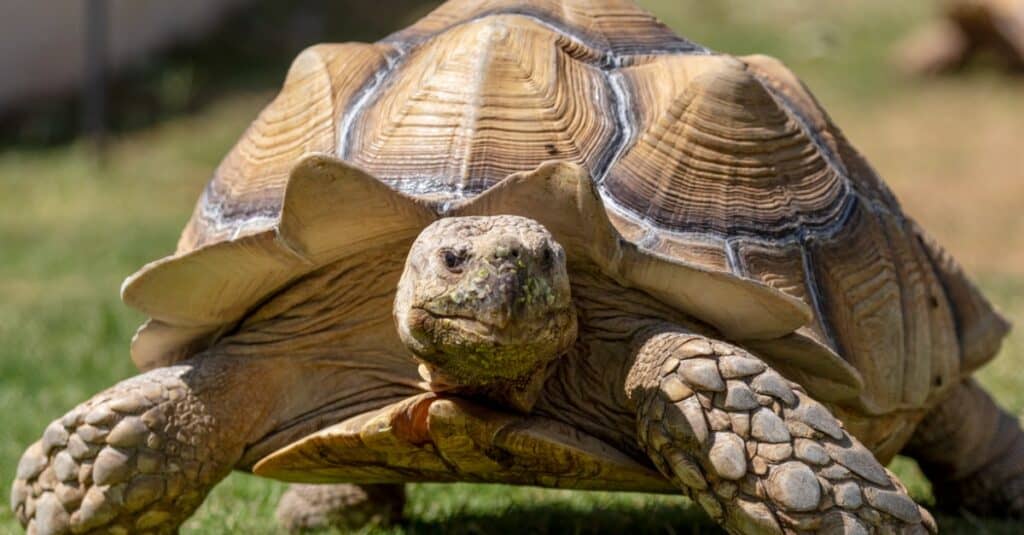
The desert tortoise estivates in the summer and hibernates in the winter.
©iStock.com/GoDogPhoto
Turtles are all members of the Testudines family, a group of shelled reptiles. Tortoises are a distinct type of turtle that inhabit the land in warm areas worldwide. They are unable to swim in water, making them very distinct from sea turtles. Tortoise species inhabit a wide range of habitats, from the humid rainforest to the hot desert.
Tortoises survive entirely on land, while sea turtles survive entirely in the water, but they are both considered turtles. There are also turtles that spend time in the water and on land known as a terrapin! There are about 356 species of turtles living on land and/or in water.
All About Tortoises
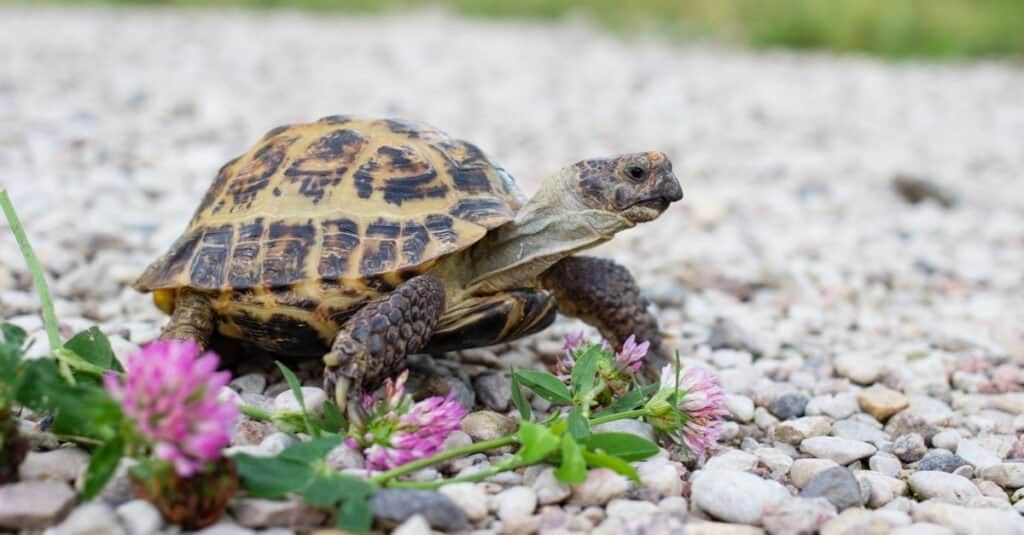
Russian tortoise
having a walk outdoors in the garden.
©Elena M. Tarasova/Shutterstock.com
Tortoises are a 220 million year old reptile family. The size of tortoises varies from small padlopers (Homopus) in southern Africa to huge tortoises (Geochelone) on the Aldabra and Galapagos islands.
Turtles are the only reptiles with a shell, made up of 59-61 bones covered by keratin-like plates. The shell is permanently linked to the spine and rib cage, so the turtle cannot crawl out. The carapace is the shell’s top, and the plastron its bottom. Turtles can feel through their shells. Tortoise shells aren’t as hefty as they might appear. Because the shell is hollow, it is lighter.
Unlike humans, tortoises do not possess teeth. These creatures’ beak-like mouths allow them to eat by biting with a rough, jagged edge. Although tortoises do not have ears like we do, the sense of vibration is all they need to know where food or a predator is hiding. Tortoises also have tough-looking skin that is quite soft under the surface.
How Long Can Tortoises Live?
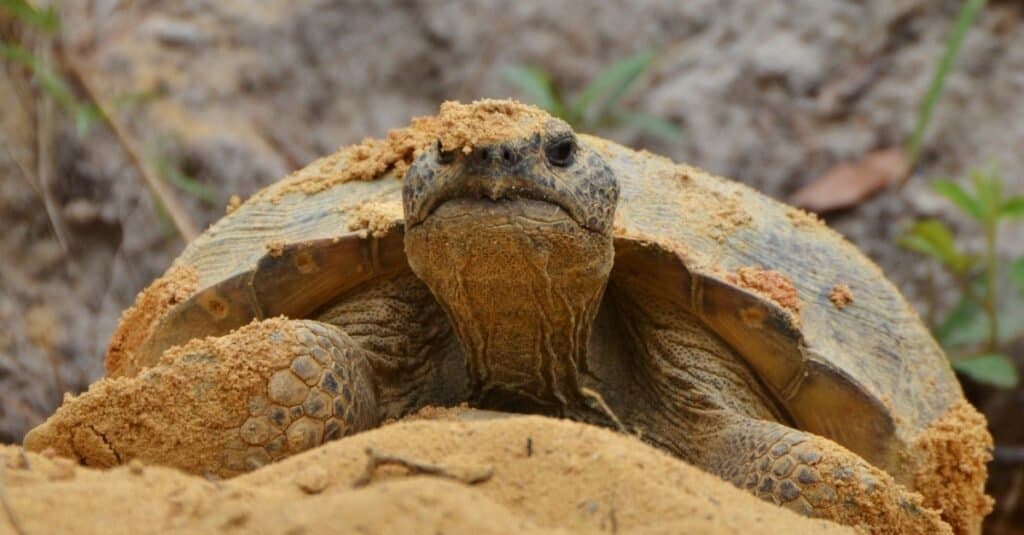
A
gopher tortoise
(Gopherus polyphemus) emerges from its burro. The gopher tortoise is an endangered species found in the southern United States.
©iStock.com/mjf795
A precise number for each turtle or tortoise cannot be given, however we may provide estimates. The lifespan of tortoises is commonly cited as between 50 and 100 years. But scientists believe that tortoises of all ages may be roaming the land. The Galapagos tortoise, for example, has been living in solitude for so long and their lifetimes are measured in centuries, it is extremely impossible to determine their age. These are the ones experts believe could have been around for four hundred years or more!
So, what’s their secret?
No one knows exactly why tortoises live so long, but a slow metabolism and a protective barrier from predators have been suggested as possible explanations…
Because of a slow metabolism, tortoises can maintain a healthy lifestyle for a lengthy period. Predators may have a tough time getting a taste of turtle meat since it is covered in a hard shell. Their serene and healthy lifestyle is also widely acknowledged. They often consume solely vegetables and avoid all fats and cholesterol in their diets.
Tortoises are one of the most docile animals on the planet. In most cases, they’re just doing their own thing, and don’t even bother to go out and hunt other animals! Tortoises prefer to live in regions where there are less predators. This may be why they love the island life so much!
The World’s Oldest Living Tortoise
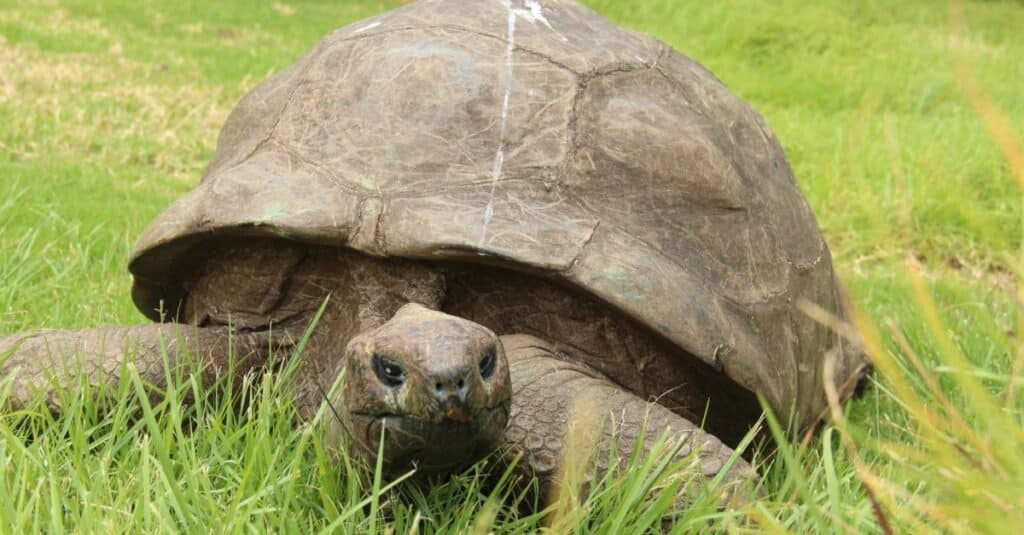
Jonathan, a Seychelles giant tortoise, and possibly the oldest animal alive, on the grounds of Plantation House on St Helena.
©Snapper Nick/Shutterstock.com
Say hello to Johnathan, a giant tortoise born in 1832. Johnathan will celebrate his 190th birthday in 2022. As a result, he is not only the oldest known tortoise, but also the oldest known land animal!
One additional subspecies of giant tortoise, Adwaitya, died in 2006 at the age of 255, and was well-known. Other tales of tortoises living for more than three hundred years have been passed down through history. A variety of giant tortoise genera exists, including extinct and still-existing species. Known as a Seychelles giant tortoise, Jonathan is the oldest known terrestrial animal still alive.
Jonathan lives on the British overseas territory of Saint Helena at a place called the “Plantation,” a Georgian estate built by the East India Company in 1791. There are three other gigantic tortoises in his new home: David, Emma, and Fred. Though he is undoubtedly blind, Jonathan has a good sense of direction. For most of the day, this tortoise lounges around on the grass and socializes. His image can be found on the back of the island’s five-penny coin, a testament to his notoriety.
Jonathan was long thought to be an Aldabran tortoise from the Seychelles’ Aldabra Atoll. However, the Seychelles Nature Trust (and other zoologists) believe he may be a rare Seychelles giant tortoise. It is estimated that there are now roughly eighty of this species left in the world.
Do Tortoises Make Good Pets?

Gopher tortoise in tunnel
©iStock.com/Paulbr
Many people like tortoises as pets because they are quiet, cute (particularly as hatchlings), and don’t shed. But tortoises live anywhere from 50 to 100 years on average. If you adopt one as a pet, be aware that it may survive you.
Unless two males are kept in the same enclosure, most tortoises are docile and shy. Two male tortoises may grow violent and attack each other, causing severe injury. Even when they’re small, tortoises should be handled minimally to avoid stress, which can cause sickness.
Species-specific diets vary, but all pet tortoises require a wide variety of foods with a focus on roughage and calcium/phosphorus balance. Many tortoise species require a big enclosure, ideally outdoors. Because of this, pet tortoises are best suited to larger land areas with milder temperatures.
It’s crucial to think about your pet tortoise’s habitat, environment, and diet before getting one. Adult size, temperature and light needs, nutrition, and whether to hibernate vary widely between species. Before buying a tortoise, do your homework on each species. Russian, red-footed (including cherry head variants), sulcata, Greek, and radiated tortoises are popular pet tortoises.
As amazing as their longevity is, the length of a turtle’s life is the main drawback for most when deciding to own one. Essentially, you’ll need to plan for your pet tortoise’s retirement, along with your own.
Are Turtles Under Threat?
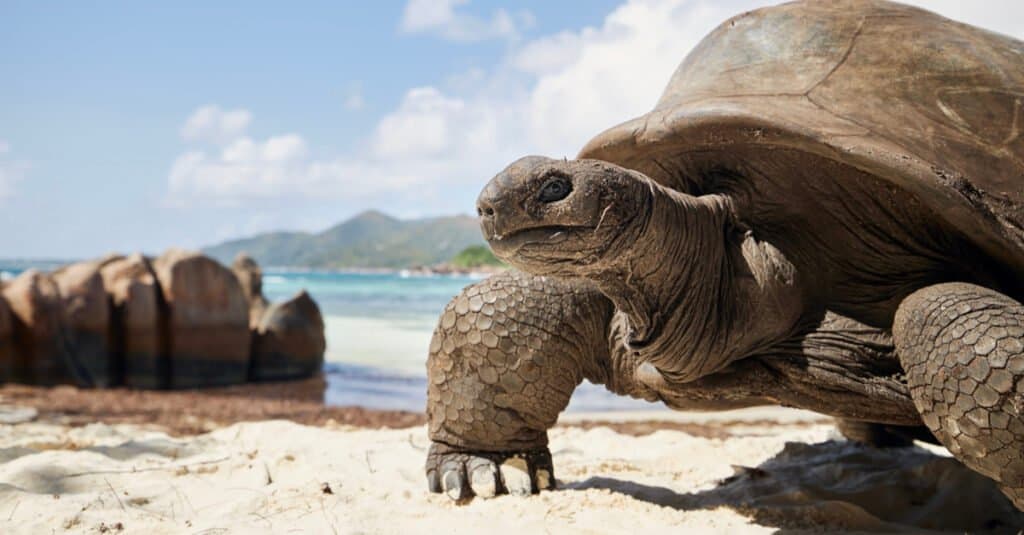
A tortoise on the beach
©Jaromir Chalabala/Shutterstock.com
Everywhere you look, habitats are being damaged or destroyed. Turtle populations are suffering in the United States because of habitat degradation along streams. Desert tortoise habitats are being destroyed by off-road vehicles, and rainwater runoff from cities is contaminating lakes, streams, and rivers with waste and toxins. As a result of the pet trade, the Roti Island snake-necked turtle is now extinct.
To rescue the world’s turtles, many countries, zoos and conservation organizations have joined together. Turtle export restrictions are being enforced, and Asian markets where turtles are marketed and exchanged are being policed by governments. Among the world’s most endangered turtles, Madagascar and Southeast Asia are home to the bulk of them. Many of the three hundred freshwater turtles and tortoises are on the verge of being saved, thanks to recent advances in conservation efforts.
The photo featured at the top of this post is © Jaromir Chalabala/Shutterstock.com
Thank you for reading! Have some feedback for us? Contact the AZ Animals editorial team.






